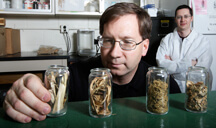

February 23, 2009
Shredding corn silage could produce more ethanol at less cost
WEST LAFAYETTE, Ind. - |
By shredding corn stover instead of chopping, as is commonly done, about 40 percent less energy is needed to gain access to more of the material stored in the plant. Dennis Buckmaster, an associate professor of agricultural and biological engineering, said that by shredding corn stover there is better access to cellulose, which is the main part of plant cell walls necessary to make ethanol.
"You can't just use a big chunk of cellulosic material. You need small particles," Buckmaster said. "What we want is access to what's in there."
Using a technique employed in food processing and other industries to measure cell damage, Buckmaster put chopped and shredded corn stalks in water and compared the amount of leachates in each solution. A leachate is any plant substance that is dissolved out of a plant or soil when it is placed in water.
According to Buckmaster's results, shredded corn stalks produced about 11 percent more leachates than chopped and 5 percent more than stalks that had been chopped and put through a roller. Buckmaster said those differences are all the more impressive when considering the energy savings tied to shredding, giving ethanol makers potentially more cellulose for less cost.
Buckmaster said that shredding corn stalks increases the surface area of the plant material. And because stalks can be shredded along the grain of the plants, like splitting a log with an ax, it takes less energy. The current chopping method, he said, is like putting the log on its side and trying to chop it with the same axe.
"It takes much less force to shear the plant material in the direction of the fibers," Buckmaster said.
Plants can be chopped again after storage to increase surface area, but that would raise energy costs beyond what is already spent at harvest, he said.
Shredding corn stalks produced pieces of different sizes, but even the largest pieces of shredded material produced about as many leachates as the smallest shredded pieces. When comparing the chopped materials, the largest pieces produced fewer leachates than the smallest pieces.
"The shredded material, even with the long particles, gives you more access to plant nutrients," Buckmaster said. "You can use chopping to reduce the size of particles, but that takes more energy and is not as efficient as shredding at harvest."
Buckmaster's study was published in the last 2008 edition of Transactions of the American Society of Agricultural and Biological Engineers. His research was funded through the U.S. Department of Agriculture's Cooperative State Research, Education and Extension Service.
Buckmaster said the next step in his research is to compare shredded and chopped cellulosic material to see which produces more ethanol. He also is working to design machinery that can be used by farmers to shred plant materials during harvest instead of using current chopping mechanisms.
Writer: Brian Wallheimer, (765) 496-2050, bwallhei@purdue.edu
Source: Dennis Buckmaster, (765) 496-9512, dbuckmas@purdue.edu
Ag Communications: (765) 494-2722;
Beth Forbes, forbes@purdue.edu
Agriculture News Page
PHOTO CAPTION:
Dennis Buckmaster, in foreground, and research assistant Bart Coffman found that shredding corn plant residue, know as stover, rather than chopping, may provide easier access to the cellulosic matter used to produce ethanol. (Purdue Agricultural Communication photo/Tom Campbell)
A publication-quality photo is available at https://www.purdue.edu/uns/images/+2009/buckmaster.jpg
Assessing Activity Access of Forage or Biomass
Dennis Buckmaster
Electrolytic ion leakage is proposed as a method to assess activity access for subsequent biological or chemical processing of forage or biomass. Smaller particle sizes and subsequent processing, which increased surface area, resulted in higher leachate ion conductivity measures. Use of ion conductivity readings to compare harvest or processing treatments requires some normalization because of potentially different chemical composition among samples. Using an abrasive cyclone mill to process a sample for use in determining a normalizing index (which is a ratio of access, relative to ultimate) yielded more consistency among whole-plant corn silage samples than blending. Longitudinal shredding of whole-plant corn silage resulted in higher activity access (as indicated by conductivity index) than precision-cut chopping or chopping plus mechanical roll processing. Shredding at harvest time seems to reduce the need for post-storage processing.
To the News Service home page
